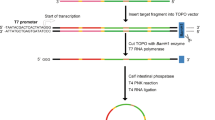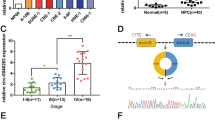Abstract
It has recently been shown that the upregulation of a pseudogene specific to a protein-coding gene could function as a sponge to bind multiple potential targeting microRNAs (miRNAs), resulting in increased gene expression. Similarly, it was recently demonstrated that circular RNAs can function as sponges for miRNAs, and could upregulate expression of mRNAs containing an identical sequence. Furthermore, some mRNAs are now known to not only translate protein, but also function to sponge miRNA binding, facilitating gene expression. Collectively, these appear to be effective mechanisms to ensure gene expression and protein activity. Here we show that expression of a member of the forkhead family of transcription factors, Foxo3, is regulated by the Foxo3 pseudogene (Foxo3P), and Foxo3 circular RNA, both of which bind to eight miRNAs. We found that the ectopic expression of the Foxo3P, Foxo3 circular RNA and Foxo3 mRNA could all suppress tumor growth and cancer cell proliferation and survival. Our results showed that at least three mechanisms are used to ensure protein translation of Foxo3, which reflects an essential role of Foxo3 and its corresponding non-coding RNAs.
This is a preview of subscription content, access via your institution
Access options
Subscribe to this journal
Receive 50 print issues and online access
$259.00 per year
only $5.18 per issue
Buy this article
- Purchase on Springer Link
- Instant access to full article PDF
Prices may be subject to local taxes which are calculated during checkout








Similar content being viewed by others
References
Poliseno L, Salmena L, Zhang J, Carver B, Haveman WJ, Pandolfi PP . A coding-independent function of gene and pseudogene mRNAs regulates tumour biology. Nature 2010; 465: 1033–1038.
Hansen TB, Jensen TI, Clausen BH, Bramsen JB, Finsen B, Damgaard CK et al. Natural RNA circles function as efficient microRNA sponges. Nature 2013; 495: 384–388.
Kumar MS, Armenteros-Monterroso E, East P, Chakravorty P, Matthews N, Winslow MM et al. HMGA2 functions as a competing endogenous RNA to promote lung cancer progression. Nature 2014; 505: 212–217.
Anderson MJ, Viars CS, Czekay S, Cavenee WK, Arden KC . Cloning and characterization of three human forkhead genes that comprise an FKHR-like gene subfamily. Genomics 1998; 47: 187–199.
Salazar M, Lorente M, Garcia-Taboada E, Perez Gomez E, Davila D, Zuniga-Garcia P et al. Loss of Tribbles pseudokinase-3 promotes Akt-driven tumorigenesis via FOXO inactivation. Cell Death Differ 2015; 22: 131–144.
Bowman A, Nusse R . Location, location, location: FoxM1 mediates beta-catenin nuclear translocation and promotes glioma tumorigenesis. Cancer Cell 2011; 20: 415–416.
Nestal de Moraes G, Bella L, Zona S, Burton MJ, Lam EW . Insights into a critical role of the FOXO3a-FOXM1 axis in DNA damage response and genotoxic drug resistance. Curr Drug Targets 2014; 15: 1–14.
Sykes SM, Lane SW, Bullinger L, Kalaitzidis D, Yusuf R, Saez B et al. AKT/FOXO signaling enforces reversible differentiation blockade in myeloid leukemias. Cell 2011; 146: 697–708.
Scodelaro Bilbao P, Boland R . Extracellular ATP regulates FoxO family of transcription factors and cell cycle progression through PI3K/Akt in MCF-7 cells. Biochim Biophys Acta 2013; 1830: 4456–4469.
Moriishi T, Kawai Y, Komori H, Rokutanda S, Eguchi Y, Tsujimoto Y et al. Bcl2 deficiency activates FoxO through Akt inactivation and accelerates osteoblast differentiation. PLoS One 2014; 9: e86629.
Myatt SS, Lam EW . The emerging roles of forkhead box (Fox) proteins in cancer. Nat Rev Cancer 2007; 7: 847–859.
Cho EC, Kuo ML, Liu X, Yang L, Hsieh YC, Wang J et al. Tumor suppressor FOXO3 regulates ribonucleotide reductase subunit RRM2B and impacts on survival of cancer patients. Oncotarget 2014; 5: 4834–4844.
Segura MF, Hanniford D, Menendez S, Reavie L, Zou X, Alvarez-Diaz S et al. Aberrant miR-182 expression promotes melanoma metastasis by repressing FOXO3 and microphthalmia-associated transcription factor. Proc Natl Acad Sci USA 2009; 106: 1814–1819.
Li J, Li P, Chen T, Gao G, Chen X, Du Y et al. Expression of microRNA-96 and its potential functions by targeting FOXO3 in non-small cell lung cancer. Tumour Biol 2014; 36: 685–692.
Boulias K, Horvitz HR . The C. elegans microRNA mir-71 acts in neurons to promote germline-mediated longevity through regulation of DAF-16/FOXO. Cell Metab 2012; 15: 439–450.
Seitz H, Youngson N, Lin SP, Dalbert S, Paulsen M, Bachellerie JP et al. Imprinted microRNA genes transcribed antisense to a reciprocally imprinted retrotransposon-like gene. Nat Genet 2003; 34: 261–262.
Shatseva T, Lee DY, Deng Z, Yang BB . MicroRNA miR-199a-3p regulates cell proliferation and survival by targeting caveolin-2. J Cell Sci 2011; 124: 2826–2836.
Fang L, Du WW, Yang W, Rutnam ZJ, Peng C, Li H et al. MiR-93 enhances angiogenesis and metastasis by targeting LATS2. Cell Cycle 2012; 11: 4352–4365.
Siragam V, Rutnam ZJ, Yang W, Fang L, Luo L, Yang X et al. MicroRNA miR-98 inhibits tumor angiogenesis and invasion by targeting activin receptor-like kinase-4 and matrix metalloproteinase-11. Oncotarget 2012; 3: 1370–1385.
Rutnam ZJ, Yang BB . The non-coding 3' UTR of CD44 induces metastasis by regulating extracellular matrix functions. J Cell Sci 2012; 125: 2075–2085.
Wang CH, Lee DY, Deng Z, Jeyapalan Z, Lee SC, Kahai S et al. MicroRNA miR-328 regulates zonation morphogenesis by targeting CD44 expression. PLoS One 2008; 3: e2420.
Shan SW, Lee DY, Deng Z, Shatseva T, Jeyapalan Z, Du WW et al. MicroRNA MiR-17 retards tissue growth and represses fibronectin expression. Nat Cell Biol 2009; 11: 1031–1038.
Lee DY, Deng Z, Wang CH, Yang BB . MicroRNA-378 promotes cell survival, tumor growth, and angiogenesis by targeting SuFu and Fus-1 expression. Proc Natl Acad Sci USA 2007; 104: 20350–20355.
Volinia S, Calin GA, Liu CG, Ambs S, Cimmino A, Petrocca F et al. A microRNA expression signature of human solid tumors defines cancer gene targets. Proc Natl Acad Sci USA 2006; 103: 2257–2261.
Ma L, Teruya-Feldstein J, Weinberg RA . Tumour invasion and metastasis initiated by microRNA-10b in breast cancer. Nature 2007; 449: 682–688.
Ebert MS, Sharp PA . MicroRNA sponges: progress and possibilities. RNA 2010; 16: 2043–2050.
Lee DY, Shatseva T, Jeyapalan Z, Du WW, Deng Z, Yang BB . A 3'-untranslated region (3'UTR) induces organ adhesion by regulating miR-199a* functions. PLoS One 2009; 4: e4527.
Jeyapalan Z, Deng Z, Shatseva T, Fang L, He C, Yang BB . Expression of CD44 3'-untranslated region regulates endogenous microRNA functions in tumorigenesis and angiogenesis. Nucleic Acids Res 2011; 39: 3026–3041.
Cesana M, Cacchiarelli D, Legnini I, Santini T, Sthandier O, Chinappi M et al. A long noncoding RNA controls muscle differentiation by functioning as a competing endogenous RNA. Cell 2011; 147: 358–369.
Nam Y, Chen C, Gregory RI, Chou JJ, Sliz P . Molecular basis for interaction of let-7 microRNAs with Lin28. Cell 2011; 147: 1080–1091.
Rutnam ZJ, Du WW, Yang W, Yang X, Yang BB . The pseudogene TUSC2P promotes TUSC2 function by binding multiple microRNAs. Nat Commun 2014; 5: 2914.
Tay Y, Rinn J, Pandolfi PP . The multilayered complexity of ceRNA crosstalk and competition. Nature 2014; 505: 344–352.
Jeck WR, Sharpless NE . Detecting and characterizing circular RNAs. Nat Biotechnol 2014; 32: 453–461.
AbouHaidar MG, Venkataraman S, Golshani A, Liu B, Ahmad T . Novel coding, translation, and gene expression of a replicating covalently closed circular RNA of 220 nt. Proc Natl Acad Sci USA 2014; 111: 14542–14547.
Haimovich G, Medina DA, Causse SZ, Garber M, Millan-Zambrano G, Barkai O et al. Gene expression is circular: factors for mRNA degradation also foster mRNA synthesis. Cell 2013; 153: 1000–1011.
Wilusz JE, Sharp PA . Molecular biology. A circuitous route to noncoding RNA. Science 2013; 340: 440–441.
Hentze MW, Preiss T . Circular RNAs: splicing's enigma variations. EMBO J 2013; 32: 923–925.
Memczak S, Jens M, Elefsinioti A, Torti F, Krueger J, Rybak A et al. Circular RNAs are a large class of animal RNAs with regulatory potency. Nature 2013; 495: 333–338.
Capel B, Swain A, Nicolis S, Hacker A, Walter M, Koopman P et al. Circular transcripts of the testis-determining gene Sry in adult mouse testis. Cell 1993; 73: 1019–1030.
Du WW, Yang W, Fang L, Xuan J, Li H, Khorshidi A et al. miR-17 extends mouse lifespan by inhibiting senescence signaling mediated by MKP7. Cell Death Dis 2014; 5: e1355.
Bartell SM, Kim HN, Ambrogini E, Han L, Iyer S, Serra Ucer S et al. FoxO proteins restrain osteoclastogenesis and bone resorption by attenuating H2O2 accumulation. Nat Commun 2014; 5: 3773.
Haeusler RA, Hartil K, Vaitheesvaran B, Arrieta-Cruz I, Knight CM, Cook JR et al. Integrated control of hepatic lipogenesis versus glucose production requires FoxO transcription factors. Nat Commun 2014; 5: 5190.
Keniry M, Pires MM, Mense S, Lefebvre C, Gan B, Justiano K et al. Survival factor NFIL3 restricts FOXO-induced gene expression in cancer. Genes Dev 2013; 27: 916–927.
Kloet DE, Burgering BM . The PKB/FOXO switch in aging and cancer. Biochim Biophys Acta 2011; 1813: 1926–1937.
Chen Q, Ganapathy S, Singh KP, Shankar S, Srivastava RK . Resveratrol induces growth arrest and apoptosis through activation of FOXO transcription factors in prostate cancer cells. PLoS One 2010; 5: e15288.
Cocquerelle C, Mascrez B, Hetuin D, Bailleul B . Mis-splicing yields circular RNA molecules. FASEB J 1993; 7: 155–160.
Jeck WR, Sorrentino JA, Wang K, Slevin MK, Burd CE, Liu J et al. Circular RNAs are abundant, conserved, and associated with ALU repeats. RNA 2013; 19: 141–157.
Yang BL, Cao L, Kiani C, Lee V, Zhang Y, Adams ME et al. Tandem repeats are involved in G1 domain inhibition of versican expression and secretion and the G3 domain enhances glycosaminoglycan modification and product secretion via the complement-binding protein-like motif. J Biol Chem 2000; 275: 21255–21261.
Cao L, Yao Y, Lee V, Kiani C, Spaner D, Lin Z et al. Epidermal growth factor induces cell cycle arrest and apoptosis of squamous carcinoma cells through reduction of cell adhesion. J Cell Biochem 2000; 77: 569–583.
LaPierre DP, Lee DY, Li SZ, Xie YZ, Zhong L, Sheng W et al. The ability of versican to simultaneously cause apoptotic resistance and sensitivity. Cancer Res 2007; 67: 4742–4750.
Yang X, Du WW, Li H, Liu F, Khorshidi A, Rutnam ZJ et al. Both mature miR-17-5p and passenger strand miR-17-3p target TIMP3 and induce prostate tumor growth and invasion. Nucleic Acids Res 2013; 41: 9688–9704.
Acknowledgements
This work was supported by a Discovery Grant from the Natural Sciences and Engineering Research Council of Canada (NSERC; 227937–2012) to BBY, who is the recipient of a Career Investigator Award (CI 7418) from the Heart and Stroke Foundation of Ontario. WY is supported by a Graduate Scholarship from Canadian Institutes of Health Research. WWD is supported by a Postdoctoral Fellowship from the Breast Cancer Foundation of Ontario.
Author information
Authors and Affiliations
Corresponding authors
Ethics declarations
Competing interests
The authors declare no conflict of interest.
Additional information
Supplementary Information accompanies this paper on the Oncogene website
Supplementary information
Rights and permissions
About this article
Cite this article
Yang, W., Du, W., Li, X. et al. Foxo3 activity promoted by non-coding effects of circular RNA and Foxo3 pseudogene in the inhibition of tumor growth and angiogenesis. Oncogene 35, 3919–3931 (2016). https://doi.org/10.1038/onc.2015.460
Received:
Revised:
Accepted:
Published:
Issue Date:
DOI: https://doi.org/10.1038/onc.2015.460
This article is cited by
-
Downregulation of circ-Foxo3 in breast cancer stem-like cells
BMC Research Notes (2023)
-
Circ-STC2 promotes the ferroptosis of nucleus pulposus cells via targeting miR-486-3p/TFR2 axis
Journal of Orthopaedic Surgery and Research (2023)
-
Role of circ-FOXO3 and miR-23a in radiosensitivity of breast cancer
Breast Cancer (2023)
-
circRNAs and their relationship with breast cancer: a review
World Journal of Surgical Oncology (2022)
-
circPDE5A regulates prostate cancer metastasis via controlling WTAP-dependent N6-methyladenisine methylation of EIF3C mRNA
Journal of Experimental & Clinical Cancer Research (2022)



